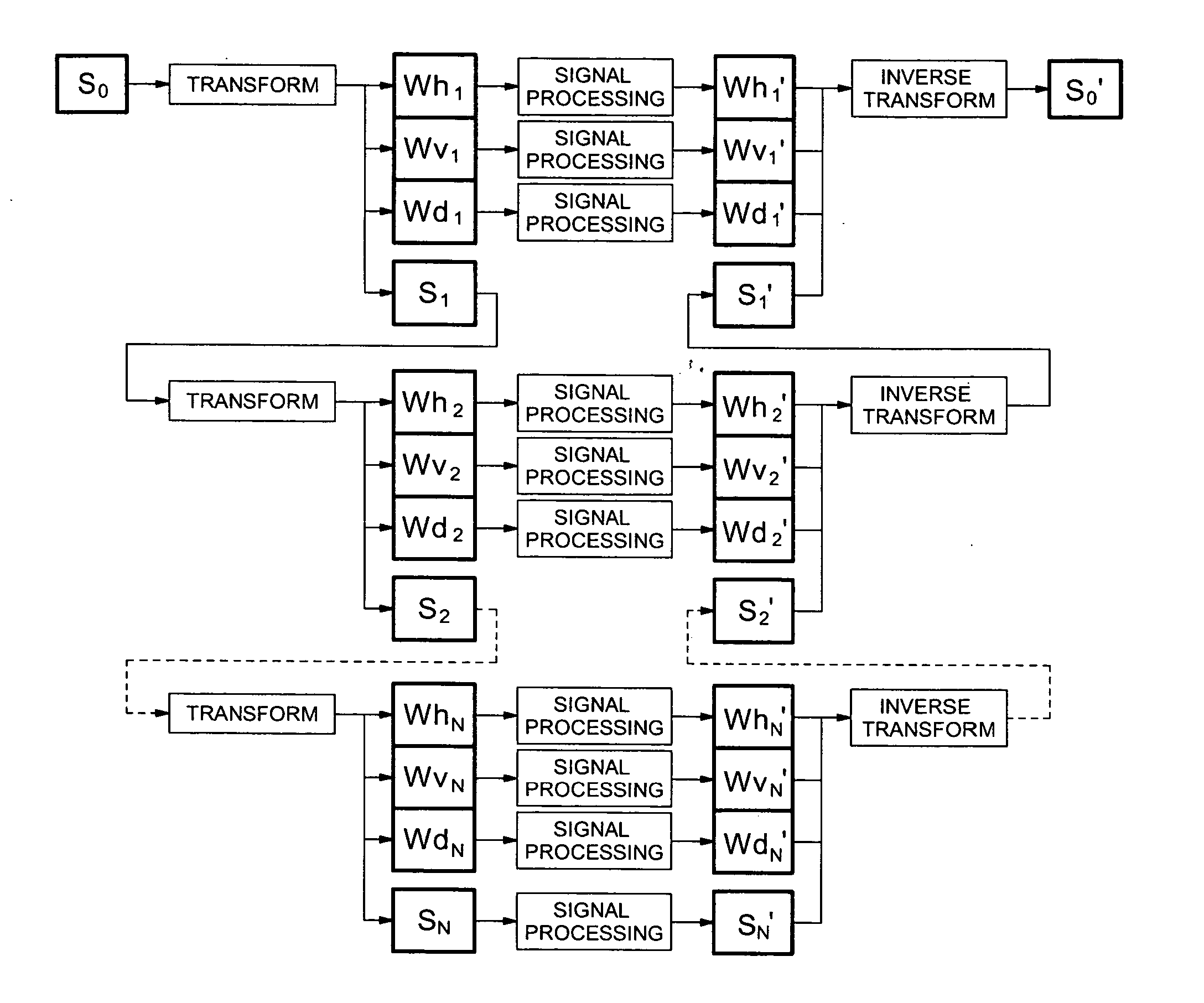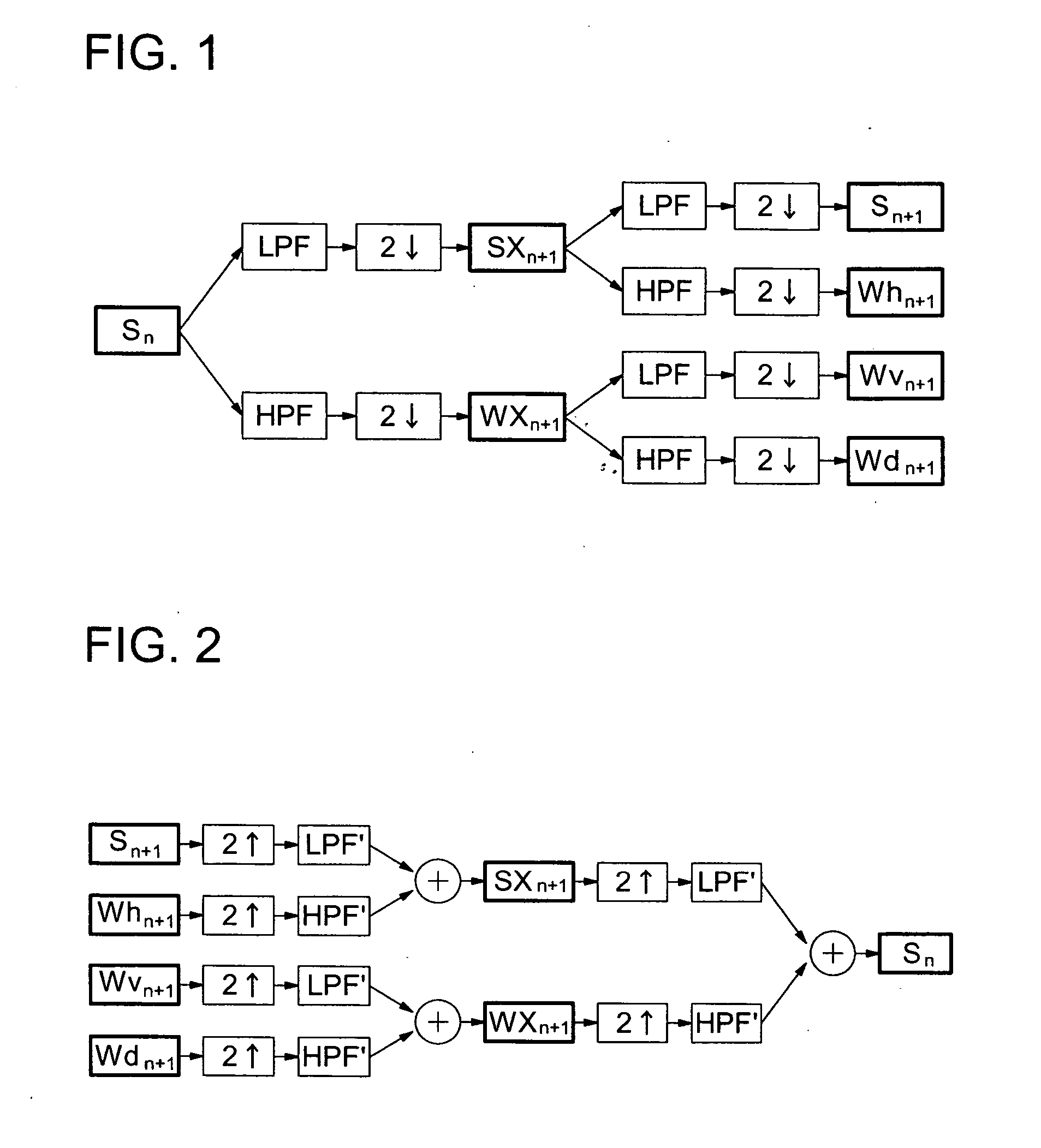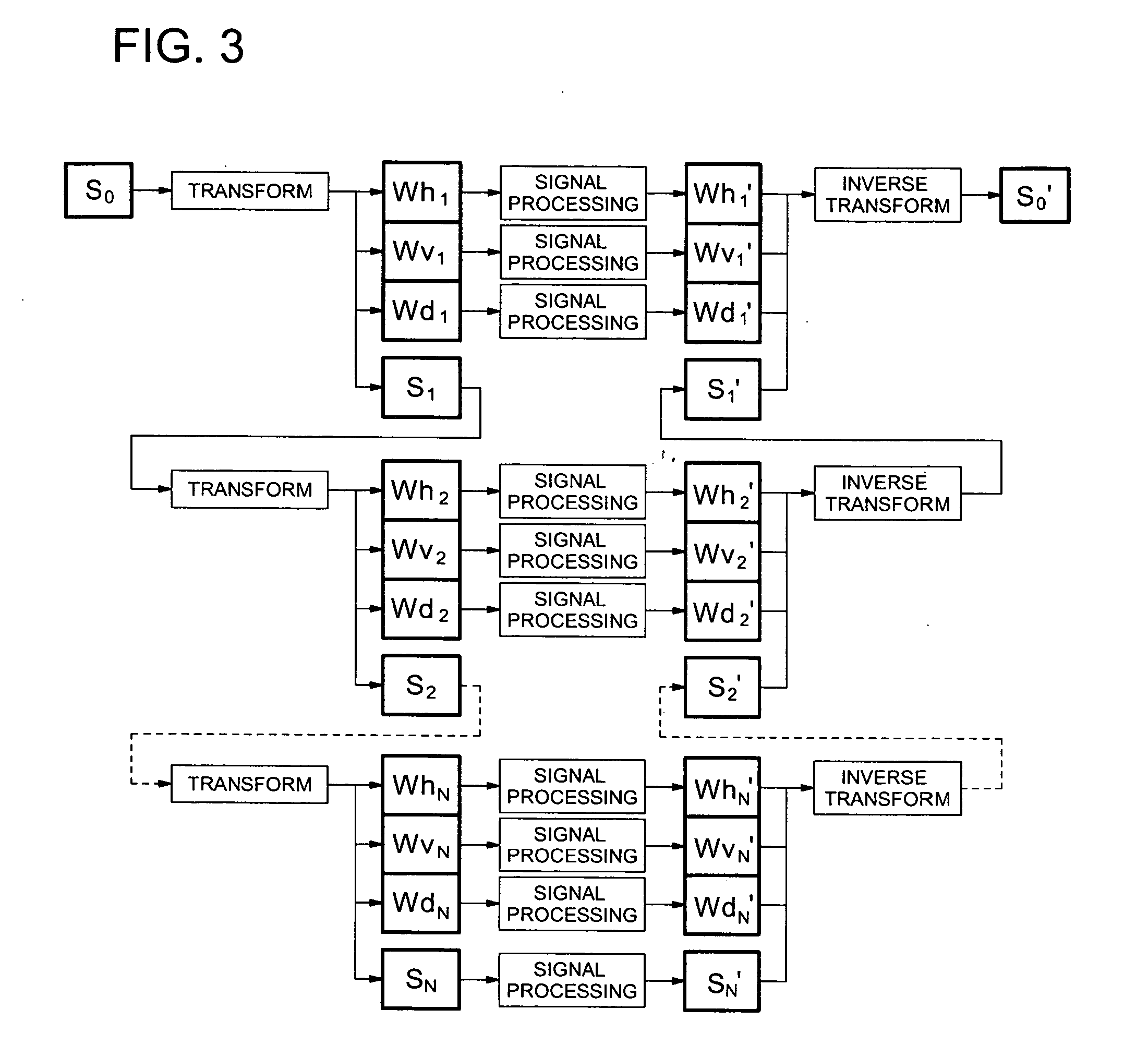It has been a point of problem that this granular
noise signal is remarkably strengthened especially with an image processing of sharpness enhancement, which degrades the quality of the image.
However, because the
noise removal based on a simple filter processing which is widely known is accompanied by the lowering of image sharpness, a satisfactory image cannot be obtained.
In a technology disclosed in U.S. Pat. No. 4,812,903 or in a technology disclosed in the publication of the unexamined
patent application S63-26783, although some effect can be recognized in the suppression of granular noise being made worse in a sharpness enhancing process, it is not sufficient, and it cannot be expected to suppress a granular noise for a signal before the processing.
If the high-frequency component is remarkably enhanced for compensating this impression of blur, the image becomes unsightly due to the generation of fine noises looking like colors being out of registration in the flat areas such as the
cheek.
Further, in any one of the examples of the embodiment described in the publication of the unexamined
patent application H9-22460, if it is attempted to enhance the sharpness in fine areas like hairs, the high-frequency component is excessively enhanced, and it is generated a noise looking as if fine powders are scattered over the whole
image area.
Further, there is another problem that, in order to separate a low-frequency component from an
image signal as intended in the publication of the unexamined
patent application H9-22460, it is necessary to apply a processing with a very large-sized
low pass filter to every channel of the
color signal representing the original image (for example, each of the signal channels of B, G, and R), which makes the load of calculation for the image processing very heavy; this is also a very big problem.
The method proposed in the publication of the unexamined patent application 2000-215307 eases somewhat the above-mentioned defect by dynamically controlling the degree of the suppression of the medium-frequency component and the degree of the enhancement of the high-frequency component in accordance with the situation, but it cannot be said that it is sufficient, and it follows the method which has the point of problem in the
image quality as it is.
However, a processing by means of a large-sized
low pass filter is required for the production of a blur image, which makes the load of calculation in the image processing heavy.
Further, in the method of abstracting a specified photographic object using a blur image, it is difficult to discriminate, for example, "a blue-
colored wall from the blue
sky", or "the
human skin from a beige-
colored wall", and the accuracy of discrimination is highly insufficient.
However, when this technology is applied to a color image, the RGB balance of a photographic object near the edge is broken and a false
colored contour is produced, which makes the image very unsightly.
On top of it, by the technology disclosed in the publication of the unexamined patent application H6-274615, it is impossible to reduce granular noises included in an
image signal.
The technology disclosed in the unexamined patent application H9-212623 is construed as a
noise removal technology to carry out what is called a hard
coring processing in which an
image signal representing a
radiation image undergoes a multi-resolution transform, and out of the high-frequency signal values after transform, those signal values not greater than a threshold is made equally to be zero; however, if said technology is applied to a color image, the RGB balance in the vicinity of the edge of a photographic object is broken to produce a false-color contour, which makes the image very unsightly.
For the above-mentioned reasons, it is impossible to use the technology disclosed in the publication of the unexamined patent application H9-212623 for a color image.
If said technology is applied to a color image, RGB balance is broken in areas where mottled unevenness is dissolved to produce false-colored spots, which makes the image very unsightly.
Further, every time at the transform of one level, it is necessary to repeat a noise abstraction processing and a
noise removal processing, which makes the load of calculation very heavy.
Further, in the images for medical use which are supposed in the publication of the unexamined patent application 2000-224421, kinds of photographic object are limited and most of the images are comparatively monotonous; however on the other hand, it is characteristic of a color photographic image that there are present mixedly in the image, areas for which different image qualities are desired respectively such as an area where fine structures densely gather against a flat area, a light area against a dark area, etc., as observed in a personal portrait with a background of a wood.
In an color image like this, it is necessary to change the condition of
noise removal on the basis of the grasping of the area structure with a wide view of it; however, in the technology disclosed in the publication of the unexamined patent application 2000-224421, it is necessary to judge the condition of a noise removal processing of the nth-level resolution on the basis of the information of the nth-level resolution concerned; therefore, it is difficult to design an
algorithm for determining the noise removal condition.
The technology disclosed in the publication of the unexamined patent application 2001-189866 can be construed as a technology to use, in applying a multi-resolution transform to a signal of an image including a still-standing grid image, a filter having a characteristic not to make the main
spatial frequency components of a still-standing grid image substantially pass it in the first-level transform; however, this technology is effective only for the removal of a noise having a periodic uniform
frequency response like a still-standing grid image, and it is not effective for the removal of a noise having a distribution in the shape and size with its
spatial frequency components not concentrated in a particular band like a granular noise in a color photograph.
This technology is one to make the speed of calculation high by carrying out the image processing and coding processing parallel in preparing an image
data file premised on the
data compression based on a multi-resolution transform; however, in the field of the color photography, it is necessary to prepare a
data file based on a common standard which does not use a multi-resolution transform such as a
JPEG file or a TIFF file in response to the request of a user, and the method disclosed in the publication of the unexamined patent application 2001-223899 cannot make the speed of the calculation high.
Further, if the technology of the publication of the unexamined patent application 2001-223899 is applied to a color image, it is produced a serious problem also in
image quality that a false-color contour is produced in the vicinity of the edge of a photographic object or that false-color spots are produced in a flat portion.
 Login to View More
Login to View More  Login to View More
Login to View More 


